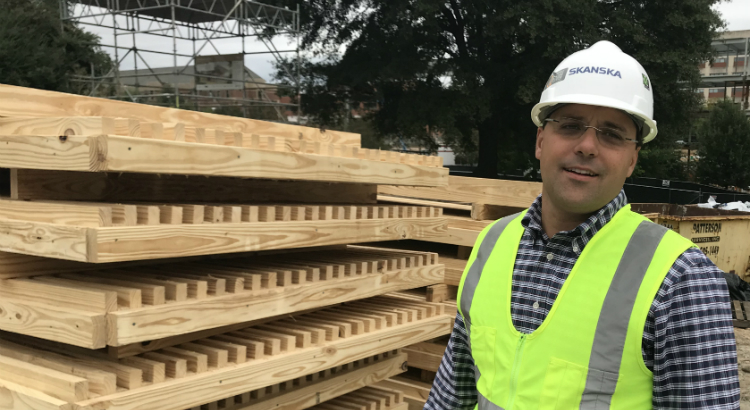Skanska USA Project Manager Jimmy Mitchell has a long-standing interest in repurposing and recycling materials for construction. So much so that he served as the founding board chair of the Lifecycle Building Center, an Atlanta nonprofit that has helped contractors and owners reuse roughly 4 million pounds of building materials since it began operations in 2011.
So, when the Swedish-owned construction giant was competing with other contractors to build the Kendeda Building for Innovative Sustainable Design at Georgia Tech, Mitchell saw great possibilities. Under Living Building Challenge 3.1, each project “must incorporate one salvaged material per 500 square meters of gross building area.” That works out to 10 salvaged materials for the Kendeda Building, and with all his experience with reusing materials, Mitchell had learned to be on the lookout for opportunities early on in the process.
“Even with an organization like [the Lifecycle Building Center] in town, you can’t be sure that you’ll be able to buy the salvaged materials you need off the shelf,” he says. Supply has to match up with demand.
Well before construction had begun, Mitchell worked with Georgia Tech and the building’s architects at Lord Aeck Sargent to snap up materials that might be appropriate for the building. Lifecycle helped with the logistics.
It also helped that the project is at Georgia Tech: The Kendeda project got first dibs on the slate tile that was removed last year from one campus building; it also had access to materials from other state-owned buildings beyond the Tech campus. The university even set aside a small warehouse one-and-a-half miles from the building site, where Mitchell was able to stockpile salvaged materials.
“I can tell you that my favorite challenge is incorporating salvage materials into the building,” Mitchell said well before construction. “We need to incorporate 10 salvage pieces [under LBC’s Net Positive Waste Imperative]. So we’re going to find and incorporate not just any 10 items, but it’s going be 10 items that will showcase a great story.”
Here are some of the salvaged materials selected for use so far.
• Slate shingles from the roof of the Georgia Tech Alumni Association building, which was replaced in 2017. The gray slate will be used as on the walls and floors of shower rooms and restrooms.
• Two-by-fours from a former church on 10th St and from dismantled movie sets are being used in the nail-laminated floor decks. Nearly 500 10-by-six-foot flooring units were assembled by workers from the community, hired — as part of the Kendeda Building’s Equity Petal — through the Georgia Works training program.
• Stone Mountain granite curbs from the Georgia State Archives Building, which was razed last year. The granite will be used as the curb around a constructed wetland on The Kendeda Building’s site.
• Heart pine joists that were initially part of Tech Tower — one of two campus’ two original buildings dating back to 1888. The heart pine will be converted to treads for the Kendeda Building’s monumental staircase.
• Lumber from storm-felled trees on Georgia Tech’s campus was stored outside the warehouse on Northside Drive and then taken to Eutree, a “forest-free” mill in Vinings, where it was kiln-dried, milled and planed. The wood will be used to make counters and benches inside the building.
PHOTO ABOVE: Skanska’s Jimmy Mitchell and nail-laminated panels at the Kendeda Building job site. Two-by-fours in the panel were salvaged from movie sites and an old church. Photo by Ken Edelstein.


